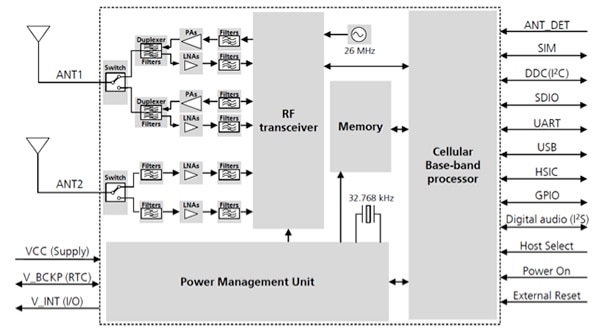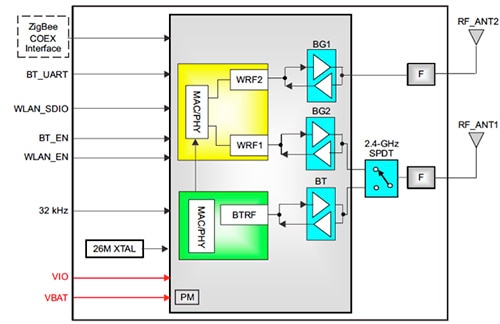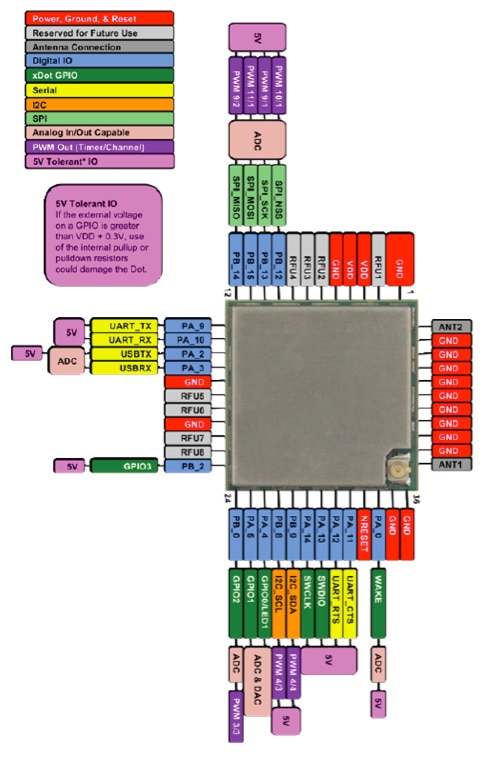Selecting the Right FCC/CE Compliant Wireless Module
Contributed By DigiKey's European Editors
2017-11-22
When designing electronic projects or products, they often require the ability to communicate with some other device. The data that needs to be transmitted can be virtually anything from weather information, medical data or operational control commands. Capable of being achieved either with or without wires, there is a wide selection of communication standards that can be leveraged to incorporate this intercommunication. Distance can be a limiting factor since it is not always possible to easily connect a number of devices together over larger distances. In this case, connecting devices by physical wires can result in an expensive and complicated installation. Wireless communication, however, offers a much more flexible solution that can reduce development costs and simplify installation.
Wireless communication generally refers to using radio waves to communicate over short distances of a few meters to longer distances of many kilometers, even up to millions of kilometers for deep space radio communications. Wireless communication techniques also include optical, sonic and electromagnetic induction methods.
There are also numerous topologies involved in wireless communication. There are point-to-point devices using Bluetooth 3.0 and lower that only communicate directly with one other device, such as a smartphone and a Bluetooth earpiece. The smartphone would normally have to disconnect from the earpiece in order to communicate with another Bluetooth device. There is also point-to-multipoint, which connects a main device to multiple other devices. Wi-Fi and Bluetooth 4.0 and above are examples of point-to-multipoint connections.
In choosing a wireless communication topology, there are a few things to consider.
Certification
Like wired communication technologies, wireless must meet compliance with local standards. As wireless compliance is much stricter, it is more difficult to pass. Radio compliance works on a few basic concepts. The device will only operate in the specific frequency allocated to that radio technology. It should not interfere with other devices outside that frequency, and it should not be interfered with by other devices operating in other frequency ranges. This is detailed in part 15 of the Federal Communications Commission (FCC) regulations. There are also rules regarding the maximum transmit power (EIRP), which is unique for each frequency range.
The FCC is the independent agency in the US that regulates product communications. In order to sell a product, it needs to comply with the FCC standards and show the unique FCC ID on the product and packaging. This situation is a little different in Europe. Certification is approved through a self-certification CE marking that involves a number of harmonized standards. The specific European directive that deals with all products using the frequency spectrum is the Radio Equipment Directive (RED), previously R&TTE. Like FCC compliance, the CE mark must be shown on a product as proof of compliance for the European market.
FCC and CE are only two of the main certification standards. Canada, Australia, New Zealand, Hong Kong, Japan, South Korea, Asia-Pacific, Africa, and South America all have their own standards, which must be met in order to legally operate a product there.
For a manufacturer, the different regional standards, and achieving what is termed ‘type approval’ for each of their products, represents a significant design and test burden. Creating a discrete wireless transceiver design requires specialized radio design expertise together with an investment in radio test equipment, which can add significant cost and time to new product development. As such, rather than dealing with the challenges of EMI generated from high-speed digital circuitry and meeting stringent EMC product regulations, many engineering teams opt for a simpler approach to incorporating wireless connectivity.
Keeping this in mind, it is typically a good idea to select pre-certified wireless modules during early product development. This ensures a reasonable time-to-market, without significant delays in getting radio compliance. The available modules can either be programmable, or need an external microcontroller/microprocessor to properly function. Many off-the-shelf modules also include an embedded or onboard antenna, reducing the number of unknowns and possible certification issues.
It is possible at a later stage of development, usually closer to mass production, to look at developing a custom wireless solution. While it can be costly to develop and obtain the relevant certification, in larger volumes the product cost can be significantly reduced. This also ensures that initial production deadlines are met, and the product can be introduced and tested in the market before further investments are made.
Selecting a wireless technology
There are a wide variety of wireless communication methods available in the marketplace. Each one has its own advantages and disadvantages. Before choosing a possible module, it is necessary to clarify which of these technologies meets the demands of the product under development. The following iterate the key points to consider when selecting a wireless standard:
- Bandwidth
- Distance
- Security
- Power
- Frequency
Bandwidth
Bandwidth focuses on how much data is to be sent and how often. Wi-Fi offers an always-on connection at data rates from 11 Mbps (802.11b) to 1.3 Gbps (802.11ac). Bluetooth 3.0 and 4.0 offer up to 25 Mbps up to 60 meters at full power, but aren’t always connected. Sigfox and LoRa, on the other hand, can transmit 12 bytes every 10 minutes, thus reducing power consumption and maximizing battery life.
Distance
The distance concerns the maximum distance between the transmitter and the receiver. Some technologies are great in short range like Bluetooth Smart (previously Bluetooth Low Energy). Other technologies, like GPS, can receive signals from satellites orbiting the planet, thousands of kilometers away.
Security
Security is a hot topic at the moment in the Internet of Things (IoT) and any other wireless device. Sending data wirelessly from one point to another adds a security issue. Some wireless technologies solve this with strong encryption, which takes a toll on battery life and can decrease bandwidth as well. Monitoring devices, which capture very basic data like temperature or humidity, are probably not worth protecting. In saying this, they can also be the weak link in a wireless network, giving access to other more secure devices. Sensitive data like credit card information needs much stronger encryption. The important factors to consider include the sensitivity of the data, other devices on the same network, and the encryption provided by the wireless standard.
Power
This is one of the most important aspects in selecting the correct module for a product. It is always a good idea to be as energy efficient as possible, not just for energy conservation, but for heat reduction which may improve product life. The difference between a battery operated device and an always-connected wall socket can significantly change how the device operates. A device that is always powered from a wall socket is much easier to design. Wireless products that run from batteries need to consider recharging, replacement or designing long-life power supplies. Initially, replacing a battery might appear a trivial task, but when a customer has many thousands of devices, such as an IoT sensor deployed in remote locations, the resources and subsequent cost required become significant.
Frequency
While the frequency is important, it is not necessarily the main criterion when selecting a wireless module. However, there may be some situations where there is saturation in a specific frequency band, or it may not be legal in certain circumstances for a product to operate in a specific frequency band. For the wireless modules described in this article, the allocated frequencies are well defined.
GSM, GPRS, EDGE, 3G, HSDPA, HSPA+, and 4G LTE
There are many different names and technologies used in digital cellular networks for use with mobile devices like cell phones. It’s useful to know they are all just evolutions of each other. General packet radio service (GPRS) and enhanced data GSM evolution (EDGE) are second-generation technologies, also known as 2G. Their download speeds are 114 Kbps and 384 Kbps, respectively. 3G is the third generation of mobile telecommunications, and high speed down-link packet access (HSDPA) is an enhancement of this with download rates of 3.1 Mbps for 3G and 14 Mbps for HSDPA. Evolved high speed packet access (HSPA+) is a fourth-generation technology that allows up to 168 Mbps. 4G long term evolution (LTE) supports HD streaming and download speeds up to 299.6 Mbps.
One of the key things to note in choosing any GSM module is the ability to future proof a product. Sierra Wireless and U-blox both provide ranges of pin-compatible modules in 2G, 3G and 4G options. This means the developer only needs to design one PCB and swap the desired module into place, easily integrating voice and data connectivity to be deployed in any region or wireless network. As the network operators move to upgrade their infrastructure, they will eventually decide to stop supporting older technologies like 2G and 3G in favor of easier to maintain networks like 4G and upcoming 5G.
A cellular module example is the LARA-R204 from U-blox. Capable of operating in the 4 and 13 bands, and designed specifically for use on the Verizon LTE network, the module is just one in the LARA-R2 product series that offers support for all LTE network bands. It can operate in single- or multi-mode configurations, is packaged in the compact LGA 100-pin form factor, and provides a number of peripheral interface options. Figure 1 shows the functional block diagram of the LARA-R2 series, highlighting the interfaces available on the base-band processor, transceiver, RF front-end, and the power management capabilities.

Figure 1: U-blox LARA-R2 functional block diagram.
When looking to integrate any wireless module into a product, it will be important to review the way communication with the host is established. UART and I2C are popular methods of interfacing, but often the availability of extra IO ports, such as GPIO and USB, aid the addition of other sensors and devices. Other features that should be considered include whether the desired communications protocol (FTP, HTTP, etc.) is supported, and increasingly important for IoT designs, the capability to update the module’s firmware over the air (FOTA). Needless to say, security features such as crypto-authentication and encryption techniques are key to provisioning a secure communications link.
Another aspect of this cellular module is the provision of two antenna sockets and dedicated transceiver front-ends. A control pin allows the host application to enable an antenna diversity function whereby the baseband processor can determine which antenna is providing the best cellular signal strength and quality for a given link.
Configuration and control of all the module’s features are facilitated through an attached host using the industry standard ‘AT’ command set. A comprehensive reference manual detailing the use of the ‘AT’ instructions across the U-blox cellular modules can be found here.
Wi-Fi and Bluetooth modules
Wi-Fi and Bluetooth are two of the most popular wireless technologies used at the moment. Wi-Fi is used by nearly every home and business as a method of connecting users to a local network and/or internet access. Bluetooth is used in a wide range of low-power devices from hands-free headsets to wireless speakers, mice, keyboards, printers, and many more. Whereas Wi-Fi is intended for high-speed communication on a local area network, Bluetooth is intended for portable equipment. They are often complementary technologies, and many modules come with both Wi-Fi and Bluetooth features.
The WF111 series from Silicon Labs is a good example of a compact-type approved 802.11 b/g/n-compliant Wi-Fi module suitable for a wide range of commercial, industrial, and consumer applications. Capable of bit data rates of up to 72.2 Mbps and providing hardware support for WEP, WPA, and WPA2 encryption, the module is equipped with SDIO and CSPI host peripheral interfaces. Available with either an internal chip antenna or a U.FL connector for an external antenna, the module is equipped with a Bluetooth coexistence function that allows a Bluetooth module to be co-located with the Wi-Fi device. This feature ensures that each module is aware of the other, helping to avoid simultaneous data transmissions that would most likely degrade link performance.
Another wireless module that combines both Wi-Fi and Bluetooth connectivity in a single device is the WL1831 from Texas Instruments (Figure 2). For designs that require both communication methods, this compact space-saving module measures just 13.3 x 13.4 x 2 mm and integrates the RF transceivers, front-end filters, RF switches, and comprehensive power management features. Two antenna sockets are provided, one of which is switched between the Wi-Fi and Bluetooth transceivers.

Figure 2: Texas Instruments WL1831 combined Wi-Fi and Bluetooth wireless module.
With power consumption, particularly with Wi-Fi being of major concern for battery powered designs, the WL1831 meets this challenge by offering a connected idle consumption of better than 800 µA.
LoRa/Sigfox modules
LoRa and Sigfox are two similar wireless technologies that both work over the 868 MHz (EU) and 902 - 928 MHz (US) frequency bands. They are not quite competitors, but operate in a similar fashion over the same frequency. They operate as low-power wide area networks (LPWAN) for wide range networks with very low data rates, making them ideal for the IoT. Sigfox is designed as an ultra-narrowband technology which can transmit up to 12 bytes every ten minutes at a distance of 30 - 50 km, and can receive up to four messages per day. LoRa, on the other hand, is designed more for a command and control scenario. The data packet size is still low, but can be defined by the user. There’s no limit on receiving data, and it has a reduced range of 15 - 20 km.
An increasing number of vendors are providing transceiver modules for these protocols. One example is the MultiConnect xDot module from Multi-Tech Systems. This LGA-packaged device is ideal for a number of IoT applications in the European region. Having a < 2 µA deep sleep current, it is anticipated that battery life could reach 10 years or more. In addition, a fully featured peripheral set is provisioned through the use of pin multiplexing (Figure 3). Module control can be achieved either through the use of the standard ‘AT’ command set, in which case no additional programming is required, or by using the ARM mbed developer libraries.

Figure 3: MultiConnect xDot LoRa module multiplexed pin peripheral functions.
Sigfox and LoRa both operate in the industrial, scientific and medical (ISM) radio bands, which are normally reserved for use other than for telecommunications. That said, there are still modules that are developed for use in the ISM band. These modules usually use their own proprietary protocols for communication. The most common frequencies for these bands are 433 MHz, 863 MHz to 870 MHz (EU), 902 to 928 MHz (US) and 2.4 GHz to 2.5 GHz.
Mesh networks
It’s worth noting that some wireless networks don’t necessarily work on a point-to-point or point-to-multipoint system. Some wireless technologies like ZigBee, WiMAX and Bluetooth Mesh, operate on a many-to-many network. This means a device doesn’t need to be in range of the device it needs to talk to, as it can pass the signal through a network of similar devices to get to the end device. A device such as the ATSAMR21G18 from Microchip is ideal for provisioning a ZigBee mesh network. In addition to the required 2.4 GHz transceiver blocks, the device contains some comprehensive crypto-authentication features, has a maximum operating frequency of 48 MHz and provides up to 17 external GPIO pins.
Conclusion
A pre-compliant module can certainly save significant costs for development and compliance testing. However, further testing of the new product before release into the market is still required, but not to the extent of a discrete design. A module is pre-compliant in and of itself, but once it is added to another system or product, its behavior could be affected.
To aid the selection process DigiKey hosts a wireless development tools product selector, an IoT product selection guide and a wireless reference design library on its website.

Disclaimer: The opinions, beliefs, and viewpoints expressed by the various authors and/or forum participants on this website do not necessarily reflect the opinions, beliefs, and viewpoints of DigiKey or official policies of DigiKey.







